"Anyone Remember Pregnant Barbie?": People Share "Messed Up" Products That Came Out In Stores And Were Discontinued
As times evolve, brands continue to come up with increasingly modern or inventive products. But sometimes, those products don't always pan out. Instead, they become notorious, much to the chagrin of the companies behind them, and are even eventually discontinued.
Warner Bros. Television Distribution / Via giphy.com
That's not to say that all discontinued products are disliked by consumers.
Recently, u/fishermen4life2 asked, "What was the most fucked up thing to come out in stores that are now discontinued?" Needless to say, there were quite a few! So here are 12 of the most messed-up things to come out in stores and the story behind why they were ultimately discontinued:
1."A Cabbage Patch doll with an eating function that ended up eating young girls' hair. I remember my cousins' getting them for Christmas. There was no off switch. The 'eating' was triggered by putting the 'food' in their mouth — the food being little rectangular pieces of plastic. It continued eating until the food was all the way in, and then it turned off. The problem was that once it got ahold of hair, it kept 'chewing.' The hair would get caught in the gears inside the head, and it wouldn't stop because it still sensed food in the mouth."

In December 1996, a New York Times article reported that a battery-operated Cabbage Patch Snack Time Kids doll had to be taken apart "piece by piece" after it "munched a 7-year-old girl's hair up to her scalp and would not let go." It took two adults more than 30 minutes to remove 20 screws, take out the batteries, and pull apart the doll's mouth. Fortunately, the little girl was not hurt. In response, a spokesperson for Mattel, the doll's maker, said that the toy was safe and there were no other known complaints about it.
The Cabbage Patch Snack Time Kids doll came out in the fall of 1996. On January 6, 1997, Mattel announced that it would stop making the doll and voluntarily offered a full $40 refund to anyone returning the toy. By then, roughly 100 incidents involving the doll "eating" children's hair and fingers — and not letting go — had been reported to Mattel, many of them after Christmas. At the time, more than 500,000 Cabbage Patch Snack Time Kids dolls had been sold.
A week before Mattel pulled the plug on the doll, the company had sent warning labels to store, instructing buyers to keep children's hair and fingers away from the doll. While testing by Mattel and the US Consumer Product Safety Commission (CPSC) did not reveal any serious safety hazards, Mattel's then-CEO Jill E. Barad said:
"Nonetheless, we remain deeply concerned with the satisfaction of all our consumers and in maintaining their long-standing confidence in the safety and value of our toys. Our job is to bring joy to children's lives. If any of our products are causing concerns, we are committed to responding in a responsible manner."
2."KITE TUBES! A boating raft that flies behind the boat — think 20 feet in the air. The year I bought a boat, they were the newest thing, with a video in the store on a big screen TV. I wanted one, but my wife said, 'Hell, no!' Our kids were about 8 and 11 at the time. The next spring, I went in, and they were nowhere to be found. I asked the salesperson about them, and she said they were recalled due to injuries. What a shock! (They still looked fun as hell.)"
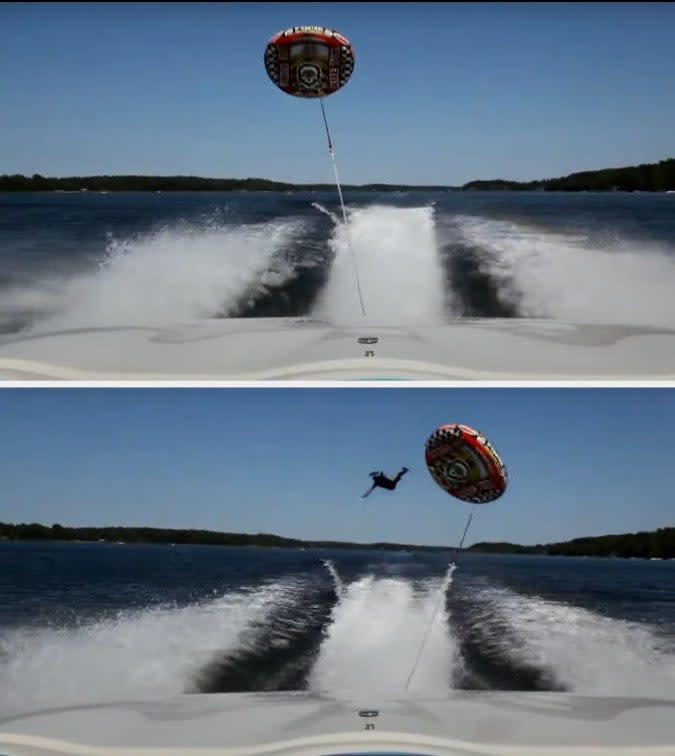
In the mid-'00s, Kite Tubes were the latest water sport craze. The Wego Kite Tubes were essentially 10-foot wide, inflatable boat tubes that were to be towed behind boats, like any other raft, except these tubes were meant to be airborne. Riders in the tube would pull on the front handles, causing the tube to catch air and take flight. They could reach altitudes of 30 feet and maintain speeds of 20–35 mph. Comparatively, the Kite Tube's main competitor, the Sevlyor Ray Manta, could only reach altitudes of 15 feet.
According to a 2006 Washington Post article, "The tubes were imported and sold through marine distributors, mail order catalogs and various retailers from approximately Oct. 1, 2005 to July 11, 2006, for about $500 to $600." Due to intense popularity, the Sporting Goods Manufacturers Association (SGMA) awarded the Wego Kite Tube the Sports Product of the Year in 2005.
While the Kite Tube had warning labels that advised a 20-mph speed limit and use of helmets, injuries were soon reported. Accidents were more common when the wind picked up. However, many safety experts were primarily concerned with impact damage due to the high altitudes that Kite Tubes reached. Many reported injuries included "loss of consciousness, broken vertebrae, ruptured eardrums, and punctured lungs," according to Life Jacket Advisor, as well as chest, back, and facial injuries. Life Jacket Advisor also notes, "Those falling from higher altitudes faced additional impact damage, as water feels increasingly solid the faster you hit it."
After numerous injury reports, the US Consumer Product Safety Commission (CPSC) issued a safety alert regarding the sport of kite-tubing, warning that riders had little control while tubes were airborne. Less than two weeks later, Sportsstuff voluntarily recalled the Wego Kite Tube after receiving two reports of death, in addition to those of serious injuries.
In a press release, the CPSC stated, "Sportsstuff has been unable to determine the cause of the incidents. Nevertheless, the company has withdrawn the kite tube from the market and is undertaking this voluntary recall out of an abundance of caution."
3."There was a product called the 'Worm Getter' in the '80s. It was basically a rod that shocked the ground outside your house. For some reason, it caused worms to come out of the ground, so you didn't have to buy them yourself. Yeah, there were about 30 deaths attributed to this thing due to people shocking themselves, and it was recalled."
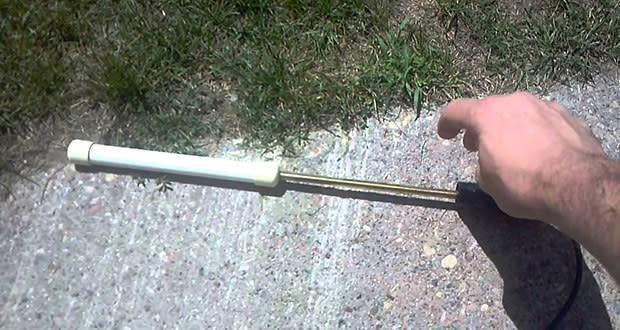
The electric "Worm Getter" was a worm probe device that shocked worms, bringing them to the ground's surface so that they could be used by fishermen for bait. Manufactured by Handy Marketing Co., the Worm Getter probes were sold in Kmart and mail-order catalog companies (Cabela’s, Bass Pro Shops, Fishing Hot Spots, the Sportsman’s Guide, and Gander Mountain) between 1980 and 1992.
In 1993, the US Consumer Product Safety Commission (CPSC) recalled the WG6-S and WG8-L Worm Getter probes after similar devices caused the deaths of more than 30 people since 1973. In the recall notice, the agency said, "Consumers have been electrocuted by contacting the exposed metal shafts and shocked by touching the ground in the vicinity of the probe."
The agency also explained that the worm probes, which could also be made at home, could "electrocute users who touch exposed metal or stand on wet soil while using them." So while the surface of the ground may be dry, the soil underneath may be moist. As such, anyone standing around the while someone used the worm prob could be at risk. Most of the reported deaths were those of children.
While no deaths were attributed to the Worm Getter manufactured by Handy Marketing Co., and the company was no longer in business in 1993, 83,000 electric Worm Getter probes were recalled.
4."Fake snow made from asbestos."
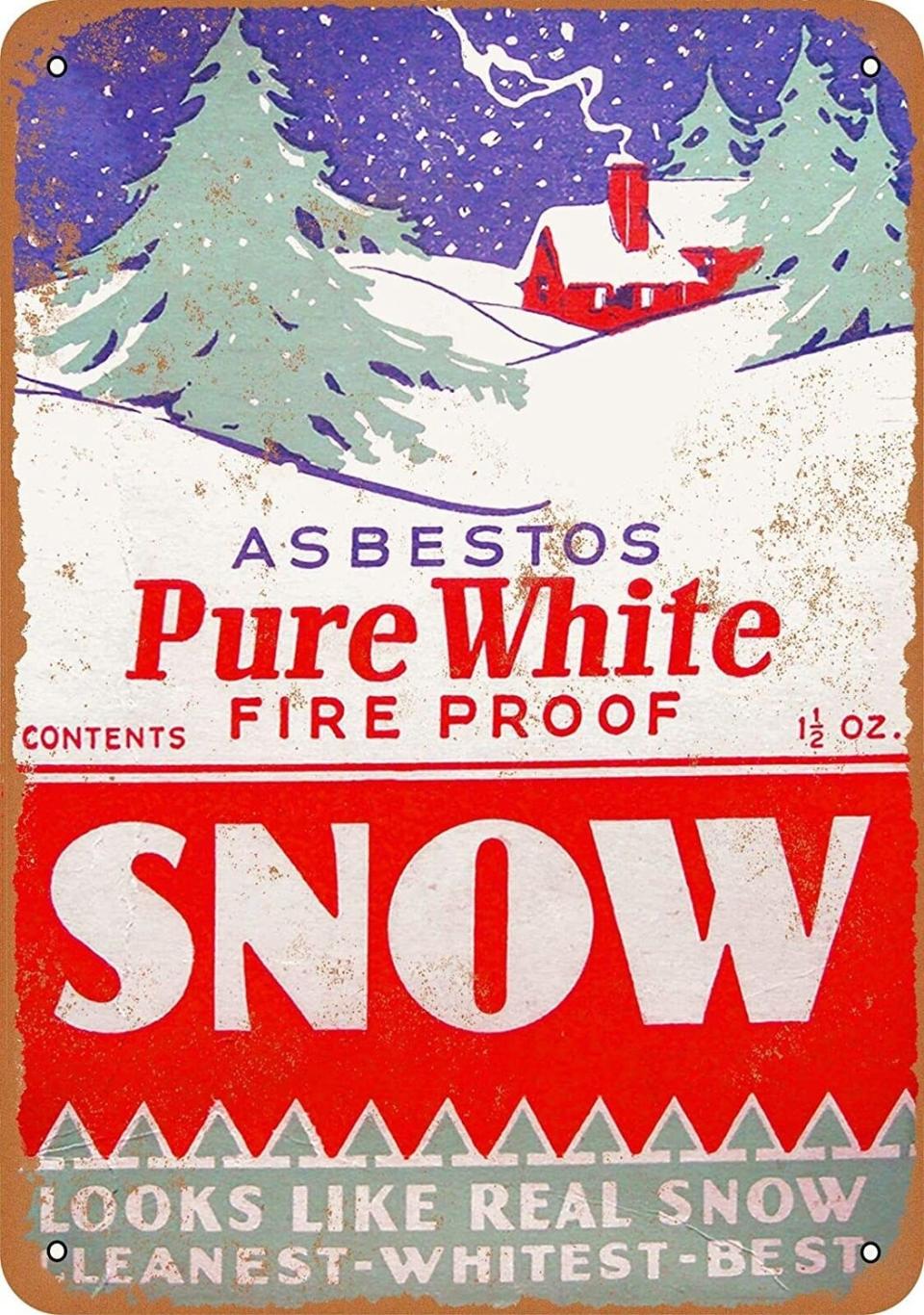
In the early 1900s, asbestos was commonly used as Christmas decor due to its fluffy, white appearance, according to Asbestos Pro Services. To preface, the National Cancer Institute explains asbestos as "the name given to six minerals that occur naturally in the environment as bundles of fibers that can be separated into thin, durable threads for use in commercial and industrial applications." There are many health hazards of asbestos exposure. Because the fibers are easily breathed in and then trapped in the lungs, asbestos can cause scarring and inflammation, leading to serious health problems. Asbestos is also a known carcinogen.
Given its appearance, asbestos was most commonly marketed as artificial snow. Consumers could sprinkle it onto their trees, wreaths, and ornaments. Therefore, even once asbestos was no longer used as decor, older Christmas decorations on which asbestos was used may contain small traces of it. Most famously, asbestos was used as fake snow in the Wizard of Oz (1939). In the scene, the "snow" falls onto Dorothy and her friends to wake them from the Wicked Witch's spell.
By the early 1900s, researchers began to notice large numbers of lung problems and deaths in asbestos-mining towns. Asbestosis was first diagnosed in the UK in 1924. However, in the US post-World War II, the popular fiber was used in everything from building insulation and car brake shoes to crayons and garden supplies.
By the 1940s, more knowledge and awareness of asbestos was spread, and by the mid-1950s, scientists determined a strong link between asbestos and lung cancer. In 1960, mesothelioma — the most commonly known asbestos-related cancer — was discovered. By the 1970s, the US Consumer Product Safety Commission (CPSC) banned asbestos in some home building materials, and by 1989 the US Environmental Protection Agency (EPA) banned the use of asbestos in new materials. The EPA also required all school buildings to be inspected for asbestos and repaired if necessary. Needless to say, asbestos was no longer being sold as fake snow to consumers by then.
5."There was that vibrating Harry Potter broom for kids."
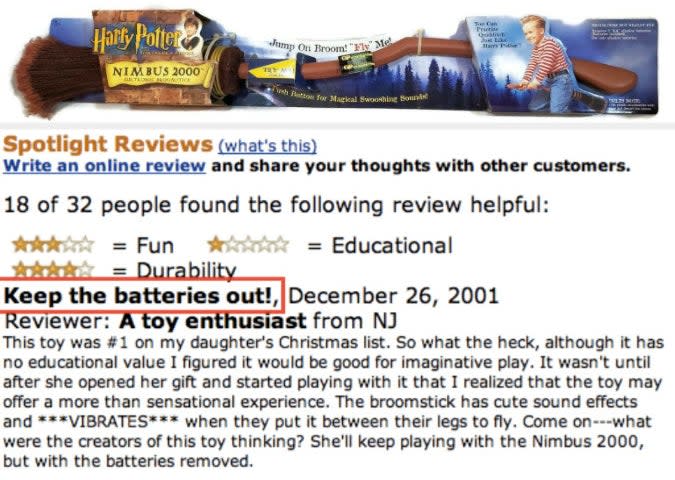
In February 2001, Mattel announced the battery-operated "Nimbus 2000," a vibrating replica of Harry Potter's Quidditch broom in anticipation of Harry Potter and the Sorcerer's Stone, scheduled to open on November 16 later that year.
At a private toy fair, then Mattel marketing director Tor Sirset, clad in a sweater vest with Hogwarts' gold seal, "Tucked the curved handle between his legs and skipped around the stage to the beat of flying sounds made by the broom." In response, toy retailers expressed doubt — not about the toy itself but that the hype would be bigger than the movies, and that readers of the Harry Potter series were "past the prime toy-buying age."
However, upon release, parents expressed shock at the toy's design and accused Mattel of perversion. Online reviewers began calling the Nimbus 2000 a sex toy, and the vibrating broom was allegedly even sold in sex shops for double the retail price. Eventually, Mattel quietly pulled the toy (though some were still sold on eBay). Nevertheless, the vibrating broom made Time's list of Top 10 Dubious Toys. While the Nimbus 2000 was all but scrubbed from the internet, some sites archived Amazon comments (including Method Shop and Time), including the following:
"Excellent!, June 11, 2002 – When my 12-year-old daughter asked for this Nimbus 2000 vibrating broomstick for her birthday, I kind of wondered if she was too old for it, but she seems to LOVE it. Her friends love it too! They play for hours in her bedroom with this great Harry Potter broomstick toy. They really seem to like the special effects it offers (the sound effects and vibrating). My oldest daughter (17) really likes it too! I recommend this for all children."
"Harry Potter Toy, August 28, 2002 – I recently bought the Nimbus 2000 toy for my son. He’s a HUGE Harry Potter fan. Seen the movie 32 times (in the theaters) and even made the paper. This toy gives him the ability to fly around the house zapping things. The only problem I see with this Harry Potter broomstick toy is the batteries drain too fast and his sister fights him over it, so now I need to buy her one."
6."Lawn Darts. These were a lot of fun but were also terrible accidents waiting to happen. They had plastic fins and a body with a weighted, pointy metal tip. I remember older kids whipping them at the schoolyard fence to see how deep they could go into the 2"x12" pressure-treated fence planks."
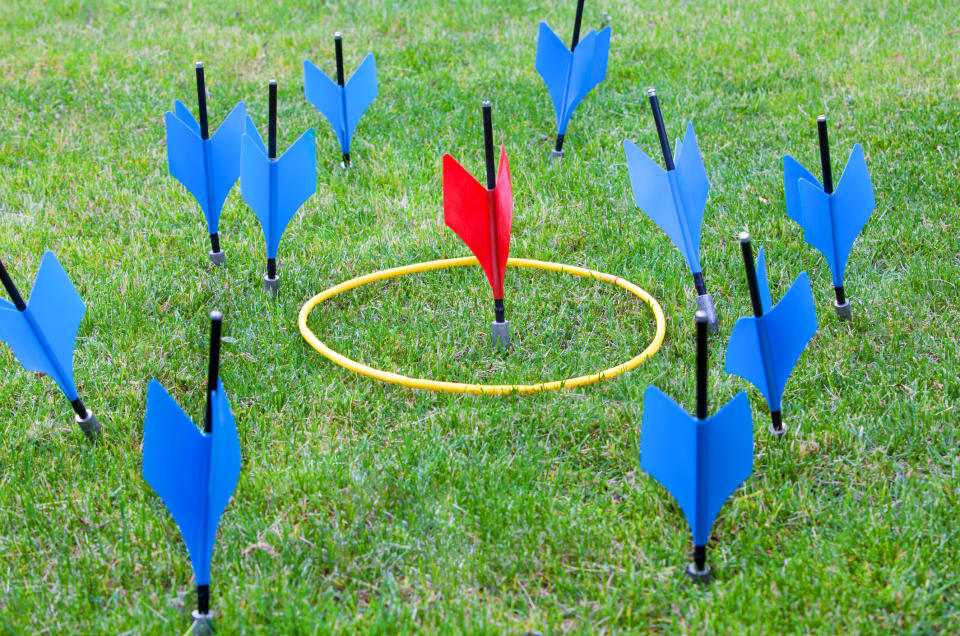
Lawn Darts, also known as Jarts, were originally sold in sets that included four 12-inch darts — comprised of a heavy metal or weighted plastic tip on one end, and three plastic fins on the other — and two targets. The intention of the game was to throw the darts at the targets; however, the US Food and Drug Administration (FDA) designated lawn darts as "mechanical hazards" in 1970.
This meant that lawn darts could not be sold unless they met three requirements: 1) Bear a specific warning label on the front of the packaging that stipulated that lawn darts were not a children's toy and may cause serious or fatal injury; 2) Include clear instructions for safety, including that they should not be used when any person or animal is around the target area, and 3) Not be sold by toy stores of children's departments. While other organizations, such as the Consumers Union and Children's Foundation, pushed for more emergency provisions and an outright ban, lawn darts were popular throughout the '80s.
In 1987, David Snow, an aerospace engineer from California, bought a volleyball set that only came in a pack of games — a pack that included lawn darts. While he kept the box in the garage, his 9-year-old son and his son's friends began playing with the lawn darts, throwing them in Snow's backyard. One child threw the dart too high, causing it to land in the front yard — hitting Snow's 7-year old daughter Michelle in the head. The lawn dart penetrated her skull, and she was pronounced clinically dead three days later.
After his daughter's death, Snow was determined to get lawn darts "off the market" and learned that despite being banned in the US due to injuries caused to children, lawn darts were sold to adults thanks to the FDA's 1970 regulation. Snow eventually contacted the Consumer Product Safety Commission (CPSC), who later discovered that over a period of eight years, an estimated 6,100 people were sent to the emergency room due to lawn dart injuries — at least 80% of victims were children who were younger than 15 — many of which led to permanent injury or disability. The CPSC also discovered that the majority of lawn darts being sold, by multiple manufacturers, were not complying with the FDA's warning requirements.
After meeting with Washington officials, and after an 11-year-old girl in Tennessee was in a coma due to a lawn dart injury, the CPSC voted to ban lawn darts in 1988 from further sale. Because the ban did not recall lawn darts that had already been purchased, the CPSC reissued the ban in 1997, urging people to destroy the game.
7."Dyed ketchup. They had to put so much dye in it that they legally couldn't call it tomato ketchup. If I remember correctly, it had a silly name, too, like EZ Squirt. Apparently, it returned porn on searches. You can still get green ketchup if it is available in your area, but I'm not sure about the other colors."

On July 10, 2000, Heinz released Blastin' Green ketchup to promote Shrek. The green ketchup was so popular that a years' worth of orders sold in the first few months of its release. Some believe the color was so successful because it seemed more natural thanks to green tomatoes.
To capitalize on the demand, Heinz released a full line of different-colored ketchup in squeezable, kid-friendly bottles. The line was named EZ Squirt. These colors included Awesome Orange, Totally Teal, Stellar Blue, Passion Pink, and Funky Purple.
As reported by WPXI, in order to make the EZ Squirt ketchup multicolored, Heinz had to strip the red coloring out of traditional ketchup and add food coloring. Subsequently, other ingredients were tweaked to maintain the same ketchup taste, and the company could no longer call EZ Squirt a "tomato ketchup."
The EZ Squirt line saw success with more than 25 million bottles sold, causing Heinz to capture 60% of the US ketchup market. Eventually, sales dwindled, and the EZ Squirt line was discontinued in January 2006.
The EZ Squirt line made headlines again in 2015, however, after a German man, Daniel Korell, scanned the QR code on a Heinz ketchup bottle to enter the company's online contest. Instead, the QR code directed him to the hardcore pornography site FunDorado.
In an email to CNNMoney, Michael Mullen, senior vice president of Corporate & Government Affairs at Heinz, said, "Heinz in Germany has apologized for the way in which an out-of-date QR code and website link to design a ketchup label in 2014 has been reassigned to an adult content web site.”
In response to the incident, FunDorado posted on its Facebook page, "Hello Daniel Korell, wow! Has Heinz perhaps confused FunDorado's Sexy Lila with its Lila Ketchup EZ Squirt? However, you won't of course be going away empty-handed. We're giving you a year's free access to FunDorado.com."
8."Many shoe stores used to have fluoroscope X-ray machines for customers to see how well their feet fit into the shoes they were trying on. They were often unshielded and highly radioactive."
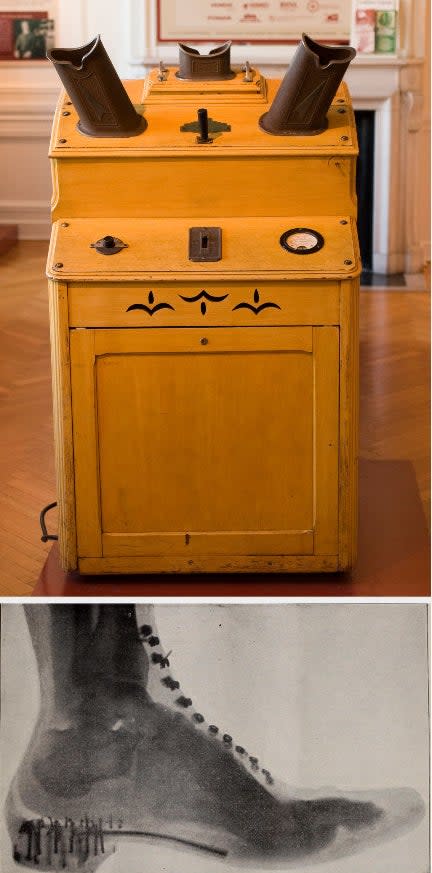
To quote IEEE Spectrum, "From early on, feet in shoes were a popular X-ray subject." In 1895, German engineer and physicist Wilhelm R?ntgen accidentally discovered the "X-ray" (X stood for the unknown, as R?ntgen didn't know what light was passing through the subject). By World War I, the military pushed for fluoroscopes to be used for shoe fittings. And in 1914, Frank Keefer included radiographs of feet in boots to show proper footwear in A Textbook of Military Hygiene and Sanitation.
Accordingly, Jacob J. Lowe, a doctor in Boston, examined wounded soldiers' feet using fluoroscopy so that they wouldn't have to remove their boots. Once World War I ended, Lowe adapted the fluoroscope for shoe stores and patented it, calling his invention the Foot-O-Scope. In the US, X-Ray Shoe Fitter Inc. became the leading producer of shoe-fitting fluoroscopes. At the time, many believed these shoe-fitting fluoroscopes to be a more scientific way to fit shoes.
To use a shoe-fitting fluoroscope, the customer stuck their foot (with their desired shoe on) into a slot, and the sales associate would switch on the X-ray stream, showing the outline of the shoe and the bones of the customer's foot on a fluorescent screen.
As radiation became better understood, the American Standards Association issued a safety code for industrial use of X-rays in 1946, limiting radiation exposure to 0.1 R per day. So how does that translate to shoe-fitting fluoroscopes? Well, a typical shoe-fitting took 20 seconds, and a 1948 study of fluoroscope machines revealed exposure ranges from 16–75 R per minute. That means customers were exposed to anywhere between 5.3–25 R per fitting.
There existed concern for radiation exposure since the early 1900s. Thomas Edison even expressed fear of X-rays after his technician, Clarence Dally, died at 39 from metastatic skin cancer. Dally is believed to be the first American to die of radiation sickness (he had developed lesions in his hands and eventually had both arms amputated before his death).
Despite concerns and reported fatalities due to radiation, an estimated 10,000 shoe-fitting fluoroscopes were operating in the US by the early 1950s. It wasn't until the dropping of the atomic bombs in World War II that Americans began to doubt the effects of radiation exposure. As a result, states began passing legislation, only allowing licensed physicians to operate fluoroscopes. By 1970, only 17 states still allowed shoe-fitting fluoroscopes.
9."Anyone remember pregnant Barbie? You could take her stomach off, and there was a tiny baby doll inside."
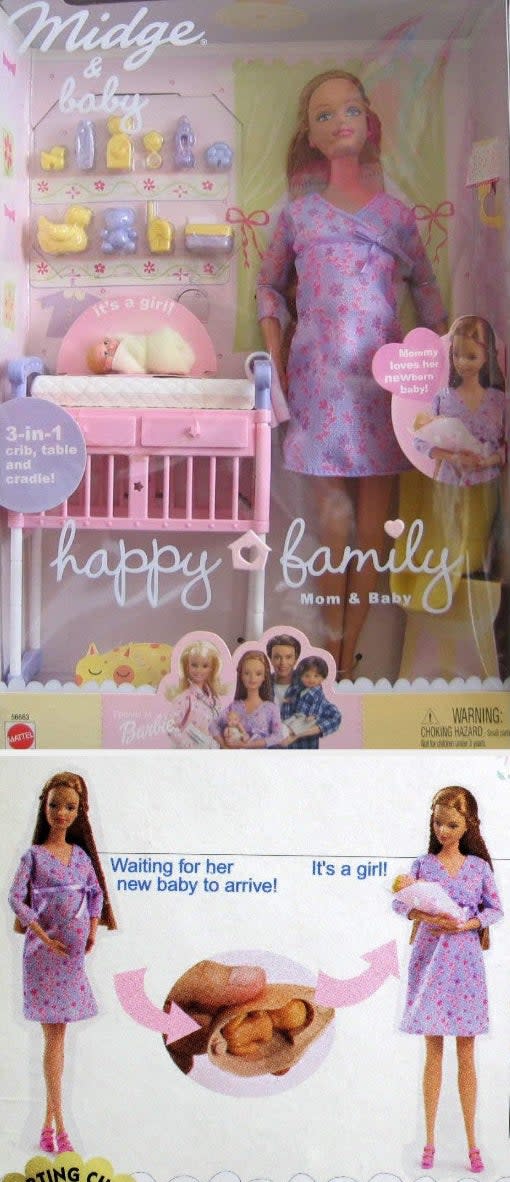
In 2003, Mattel introduced the "Happy Family" Barbie line, featuring Barbie's best friend, Midge (who was introduced in 1963), Midge's boyfriend-turned-husband Alan (introduced in 1964), and their kids: 3-year-old Ryan and newborn Nikki. In the line, the Midge doll was sold as pregnant with the Nikki doll in her detachable, magnetic stomach. So when her stomach was "opened," a curled-up baby popped out.
The pregnant Midge doll generated a lot of controversies. Mattel's website explained that the "Happy Family" line could satisfy nurture play and be "a wonderful prop for parents to use with their children to role-play family situations — especially in families anticipating the arrival of a new sibling." However, many parents disagreed. Some complained that the doll promoted and glamorized teen pregnancy. (Midge and Alan were married in the 1991 "Wedding Day" set.)
In response to the outcry, Walmart pulled the pregnant Midge dolls from their shelves. A spokeswoman for Walmart said at the time, "It was just that customers had a concern about having a pregnant doll."
Eventually, Mattel pulled the line, and Midge was later reintroduced in the "Happy Family" line sans her pregnancy. In 2013, Mattel revamped Midge and again reintroduced her, but this time without children and Alan.
10."That toy doll that would laugh when you shook it back and forth. Needless to say, small children who had infant siblings did that, and some died or had severe injuries."
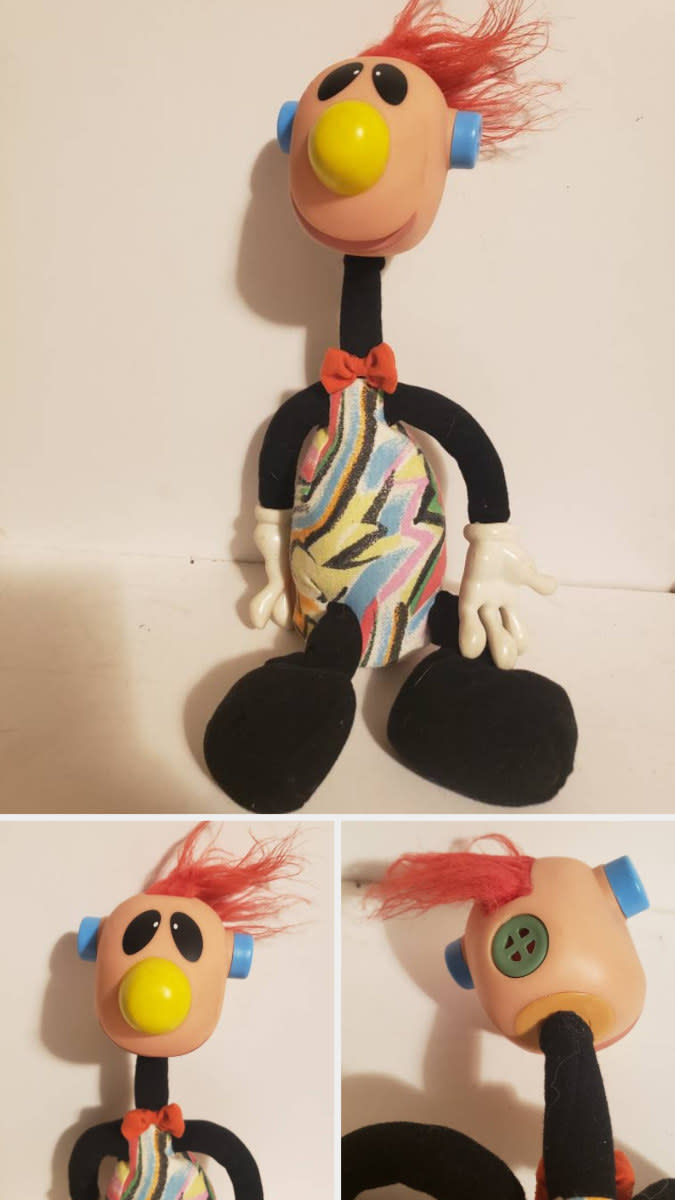
In the mid-90s, toy company Ertl released the Jibba Jabber doll. The doll came in different hair colors and had a long neck, but its defining feature was the strangled, choking sound that it made when shaken, like a groan tube.
The Jibba Jabber was mostly promoted as a stress reliever for adults. In fact, a 1994 USA Today article about "toys taming executive stress" said, "As for the popularity of Jibba Jabber and Vac-Man, 'That's displacement,' [John Jones] says. 'Better the doll than the boss.'" The article continued, "Several executive toy testers said it reminded them of their employees."
In 1995, the Jibba Jabber was again featured in a USA Today article about "corporate gifts that aren't dull." The article noted, "Chuck Bekos, an economic consultant for the state of Wisconsin, recommends Jibba Jabber, a doll that babbles and squeals zanily when shaken. 'You can imagine it's somebody you're mad at and shake that thing instead of hitting your colleague,' he says."
However, due to the nature of the toy, Ertl was informed of Shaken Baby Syndrome, a serious brain injury resulting from forcefully shaking an infant or toddler. As the US Advisory Board on Child Abuse and Neglect reported in 1995, "When told about Shaken Baby Syndrome, [Ertl] voluntarily worked with the NCPCA to place an insert in Jibba Jabber packaging explaining that while Jibba Jabber is for fun, a lethal form of child abuse involves the shaking of babies. The pamphlet lists seven ways to react positively to a child rather than resorting to violence."
Despite the stress-relieving intentions of the Jibba Jabber, the doll was later discontinued.
11."Rely, a brand of tampons back in the '70s, were designed to be left in for YOUR ENTIRE CYCLE — which, of course, made them breeding grounds for all kinds of nasty bacteria and led to toxic shock syndrome. Needless to say, they don't make those anymore."
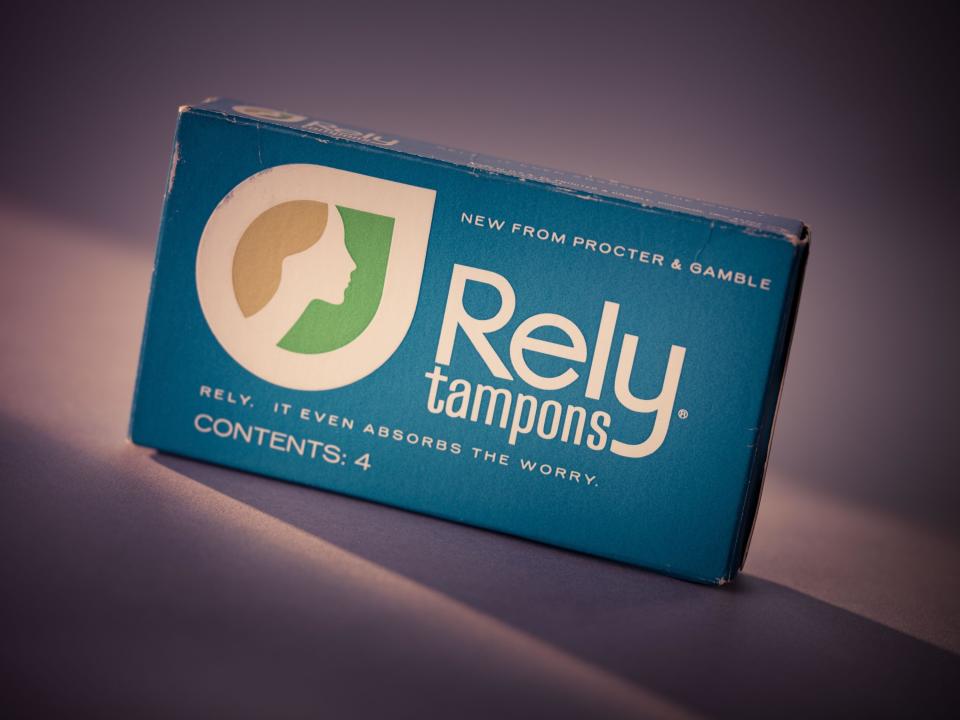
For context, as stated by Mayo Clinic, "Toxic shock syndrome (TSS) is a rare, life-threatening complication of certain types of bacterial infections. Often toxic shock syndrome results from toxins produced by Staphylococcus aureus (staph or S. aureus) bacteria." That is to say, TSS can affect anyone. However, risk factors include the use of tampons, as well as skin wounds, surgery, and contraceptive devices.
TSS was first identified in children, including both boys and girls, in 1978. By 1980, TSS dominated headlines as an epidemic associated with tampon use. That same year, the Center for Disease Control created the Toxic Shock Syndrome Task Force to learn more about the disease, and implicated Rely tampons as "the single tampon most contributing to the onset of toxic shock syndrome."
In 1975, Procter & Gamble released Rely, a brand of super-absorbent tampons. Rely tampons were advertised to absorb nearly 20 times their weight in fluid. While other tampons of the time used cotton or rayon, Rely tampons were made with carboxymethylcellulose (CMC) — an edible thickener used in foods like puddings and ice cream — and compressed polyester "beads" for better absorption. As a result, the brand claimed to hold up longer than other tampons, which meant people could leave Rely tampons in for longer, too.
Because Rely's branding focused on super absorbency and allowing people to wear them longer, and because the CDC reported that Rely users were at increased risk for developing TSS, many people believed TSS to be caused only by leaving a tampon in for too long. While high-absorbency tampons of any brand are associated with a higher risk for developing TSS, tampons themselves do not cause TSS. TSS is caused by S. aureus bacteria. Therefore, Rely was likely implicated for reasons more complex than the length of use.
As explained in a 2011 essay published in the Yale Journal of Biology and Medicine, the gelled CMC that Rely was made with "acted like agar in a petri dish," providing a suitable environment in which bacteria could grow. The polyester beads further offered extra surface area for growth. While the vagina normally has an acidic pH to keep bacteria in check, it's been hypothesized that tampons introduce oxygen and carbon dioxide into the vagina. This, coupled with the super-absorbent, long-lasting nature of Rely tampons, left the vagina drier than usual. It also increased the risk of minor ulcerations when inserting or removing Rely tampons, leaving an opening for bacteria. In addition to the length of time used, these factors combined led Rely tampon users to be at a higher statistical risk for developing TSS.
Consequently, Procter & Gamble voluntarily recalled Rely in September 1980, after the CDC released its report.
12."They removed Pop Rocks for a while because we, as kids, would slug a pack down with soda. Great burps. Some parents obviously were freaked out as they thought their kids would explode. They were back on the shelves once it was figured out that they were pretty harmless."
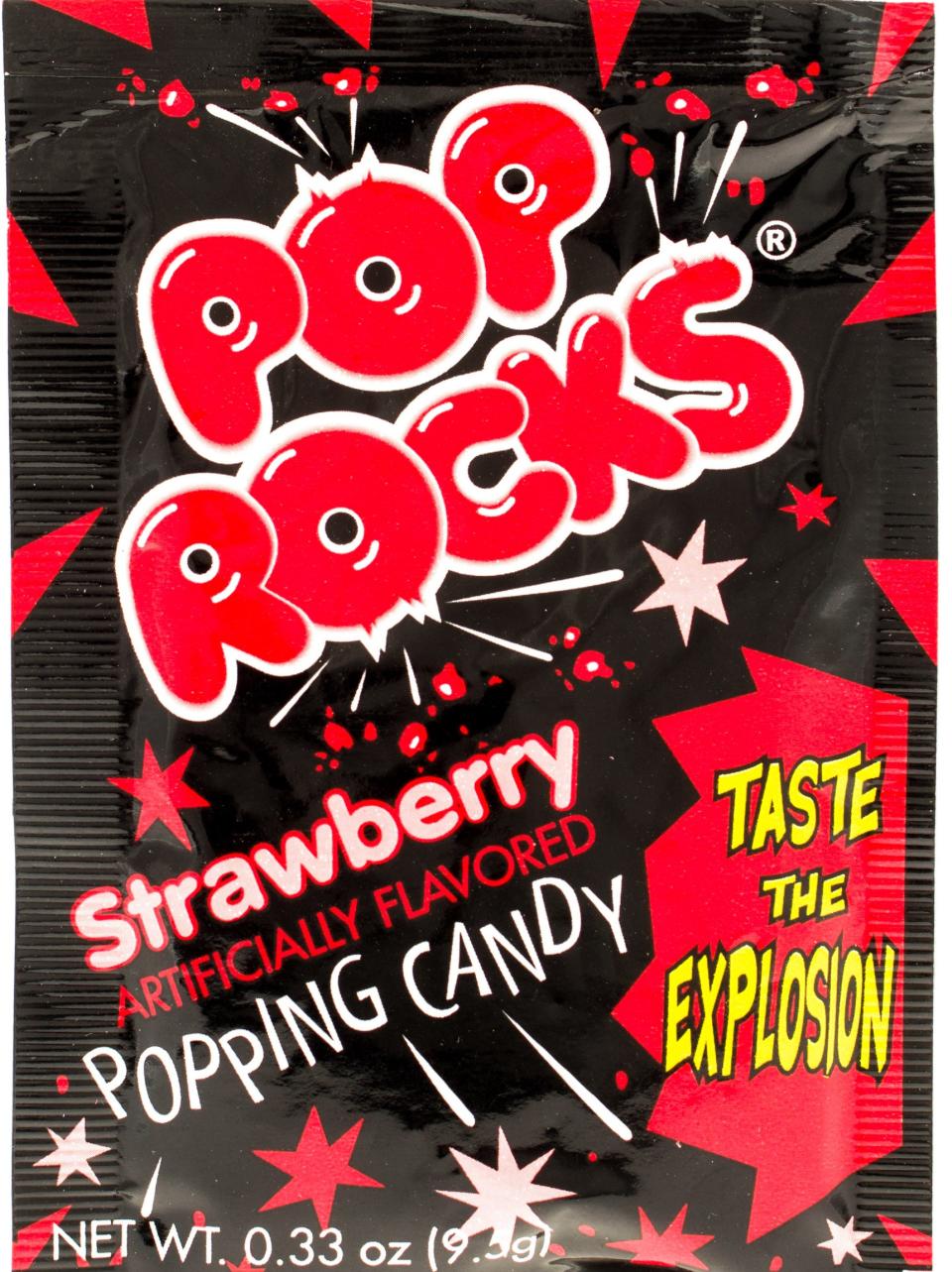
In 1956, a chemist created Pop Rocks for General Foods in an attempt to make instant carbonated soda. In 1976, the company slightly reworked the formula and began selling the candy to the public. But by 1983, General Foods withdrew Pop Rocks, claiming that the candy lacked marketplace success.
At the time, many wild rumors surrounded Pop Rocks. One claimed that eating Pop Rocks while drinking soda would cause your stomach to boil and explode. (In an episode of MythBusters, Adam Savage and Jamie Hyneman tested and disproved this.) Another claimed that John Gilchrist — a child actor known as "Little Mikey" in TV commercials for Life cereal — died after having large amounts of Pop Rocks and Coca-Cola (John Gilchrist is alive and turned 54 in 2022).
While these rumors were unfounded, the US Food and Drug Administration set up a hotline in Seattle, Washington, to assure anxious parents that the exploding candy would not cause their children to choke or explode. General Foods also sent letters to school principals and parents and created ads to explain that Pop Rocks contain 10% of the carbon dioxide found in a 12-ounce container of soda — so less gas than half a can. Consequently, many attribute the poor sales that General Foods cited when pulling the candy to these rumors.
In 1987, Pop Rocks were re-released by a new manufacturer and continue to sell today.